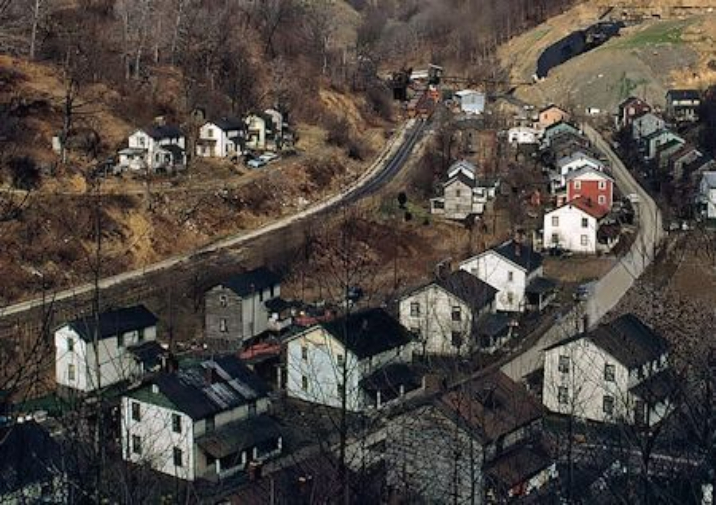Appalachia, a mysterious mountain range shadowed by a long bloody history, is a region of legends. A voluminous mountain range spanning multiple states, including Pennsylvania, Ohio, West Virginia, Virginia, Tennessee, Kentucky, North Carolina, South Carolina, Georgia, and Alabama, and home to various subcultures with populations drawn from Northern Ireland, the Scottish Borderlands, Huguenots, and the city streets of London, the Appalachian people own an old American culture and were once a definitive part of its cultural foundation, playing an important role in many of its wars, the American archetype of the rugged frontiersman, and the political machinations of the Upper South and Midwest. While the various sections of the Appalachians have received a fair share of attention or influence in one form or another, Eastern Kentucky, the northern tip of the Cumberland Plateau, remains discarded and forgotten. Once characterized by its poverty, family feuds, wanton violence, “white trash” inhabitants, and unforgiving frontier status, they became lost to time save for their abundance of various untouched hardwood forests and large deposits of coal, ripe for abuse following the War Between the States. Were it not for the publication of Harry Caudill’s Night Comes to the Cumberlands in 1960, the region would have remained an insignificant backwater forced to undergo never ending pillaging for its natural resources, yet its current status leaves much to be desired. This essay will cover the history of the people of East Kentucky and their current status.
Bypassing the pre-European history of the state, East Kentucky was originally settled by a mix of Scotch-Irish Borderlanders and poor Londoners off the streets. This rugged group of miscreants, lowlifes, petty criminals, or abused populations looking to escape politics adapted well to the mountainous frontier during the 17th and 18th Centuries. Off-put by government friendly Anglicanism, politics, educations systems of the time, and generally anything perceived as relating to the governing authoritative system, these frontiersmen would, over time, lose their abilities to read and write but would gain a heightened set of physical skills and toughness.
The War Between the States brought considerable change to the region. Reconstruction and the Gilded Age which followed it brought with them the attention of the timber industry. These companies made off rapidly with vast swathes of ancient hardwood trees, and the mountaineers, long subject of indigence, were happy to clear cut the land for pay. The work was swift and devastating. The fertile hillsides lacked the natural means to combat erosion and runoff, and the soil quickly degraded to the point of producing pathetic yields for the crops the natives planted.
It was during this same time frame that coal industries also began eyeing East Kentucky. The Coalfield region earned its namesake beginning around 1880. Coal companies and timber companies took advantage of the mountaineers’ lack of literacy by utilizing silver tongues and promises of a prosperous future so as to have the natives give away their land for pennies on the dollar. The destruction of the mountains’ natural resources began here, and the mountain men were often happy to assist in its demise. Thenceforth, the clearcutting of the ancient hardwood forests took place, causing the erosion of the fertile topsoil due to the lack of trees. Coal proved a dangerous and pollutive industry with great repercussions to follow. However, this period did bring the railroad into the mountains.
The greatest boom the Kentucky Coalfield region experienced came about during World War I and continued into the Roaring 20’s. Improved machinery, a growing urbanized population, the invention of motor vehicles, America’s entrance into the Great War, and rapid industrialization led to an instantaneous high demand for coal. Once again, coal companies grew exorbitantly wealthy while investing very little money into the areas they owned, further depleting the natural resources and leaving miners underpaid.

Throughout the period from 1890 into the Roaring Twenties, Negroes and foreigners flooded into the area. Negroes moved in largely as a result of often being railroad laborers during construction. Numerous immigrants flooded into the Kentucky Coalfield looking for work, primarily originating from Italy, Hungary, Poland, Rumania, Albania, and Greece. This created a previously unseen ethnic conflict within the mining towns. This boom would not last though.
The Great Depression incurred a collapse of the coal industry. The economic downturn hit the coal companies hard, driving many corporations into bankruptcy. This resulted in the recession of the coal industry from Cumberland life, rendering numerous mines abandoned, and leaving swathes of the local populace out of work. Subsequently, a majority of the Eastern European immigrants living in the area emigrated to other states in search of work. A few did remain behind, and much admixture took place over the years since their first appearance. The trend of emigration, regarding the foreigners and the native mountaineers, decades after the Depression ended due to the availability of better work in the industrial growth of the Midwest and elsewhere, caused “brain drain” and a long-term dysgenic effect on the population. This was exacerbated further throughout the first half of the 20th Century by the mountaineers’ dislike of education, causing many teachers and other educated individuals who wished to aid their fellow ethnics to pack up and leave.
During the 1930s, labor unions began working diligently to recruit miners into their ranks. Receiving lukewarm reception prior to the Depression and constant crackdowns from the powerful coal corporations, the indigence of the time and prestigious leadership of United Mine Workers president John Llewelyn Lewis drove the natives into labor unions in vast numbers, most notably the aforementioned United Mine Workers of America. The famous Coal Wars soon followed.
The 1950s brought with it technological innovations in the coal mining industry, and with it the utter eradication of the remains of the Cumberland ecosystem. Bulldozers, backhoes, power shovels, and other such diesel and petroleum fueled machines allowed for the rapid mining of coal and led to the rapid adoption of the strip mining method. What was left of the East Kentucky Coalfield’s environment was then left all but nonexistent. Kentucky has not recovered from this as of yet.
Today, the coal industry stands as a pathetic shadow of its former glory. Petroleum surpassed coal as the primary source of fuel worldwide during the mid-20th Century, decreasing demand. This, along with unremitting mechanization and strip mining, has led to a slow but steady decrease in demand for human labor in mines. Though the amount of coal mined did continue to generally, yet unstably, increase throughout the latter half of the 20th Century, it peaked in 2008 and rapidly collapsed afterward, a continuing trend in 2022. Additionally, the power of the miners’ labor unions has been on the decline since the 1960s and has been largely impotent for decades. Former President Donald Trump’s acknowledgement of the situation of the Appalachian coal miners and his promises to revitalize the coalfields led to his electoral successes in those regions in 2016. However, he failed to do so. Coal miners continue to lose jobs with no end in sight, especially as Trump’s successor appears uninterested in aiding the working-class.
The future of East Kentucky appears grim. Upon investigating the history of the people of East Kentucky, their entire existence, from the Colonial Era until the contemporary time of this writing, is mired in relentless tumultuousness, of both their own doing and the working of meddling outside corporations. Harry Caudill worked diligently to build the region and bring public attention to the hardships his people faced in Kentucky. It worked for a time, but his pleading fell on deaf ears. His endorsements of William Shockley’s theories of eugenics would ultimately cement Caudill as a now forgotten politician in the dustbin of American history. As ghost towns dot the region and the brighter pupils move away in search of superior opportunities, the native descendants of the mountaineers continue to wither as they carry on the coal engulfed tradition of their fathers and grandfathers. No sunshine appears on the horizon though. Both major parties loathe the working-class, and a continuous tidal wave of Northern, urbanite Carpetbaggers is gentrifying and transforming Appalachia into a post-modern monstrosity, emulating the cesspools they fled from. In the meantime, the coal miners of Kentucky continue to go ignored.
“The White people of the South are the greatest minority in this nation. They deserve consideration and understanding instead of the persecution of twisted propaganda.” –Strom Thurmond






My father’s family moved from eastern Kentucky in the 1950s, when he was about 10 years old, to a northern state in order to find work. My father never talked to me much about his childhood, but I always had the sense that he missed Kentucky for all the rest of his days.